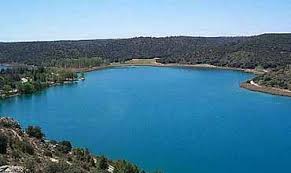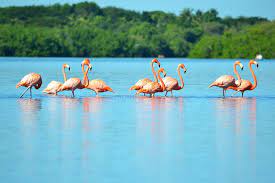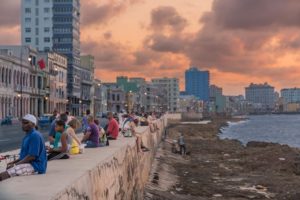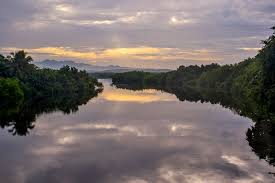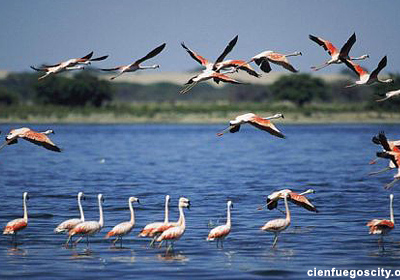UNKNOWN CUBA: THE LAKE OF GUANAROCA, CIENFUEGOS. PHOTOS
Circular lagoon that penetrates the bay of Cienfuegos from the southeast and into which an arm of the Arimao River empties. It is itself a lagoon. The Guaranoca Lagoon. Formed by the Arimao River before flowing into the Bay of Cienfuegos. It is a protected area that includes the Laberintos de los Naturales, Cayo Ocampo and other minor keys in the interior of the bay. It has great biological diversity and natural beauty.
IT IS FOUND located about twelve kilometers from the Pearl of the South, east of the Bay of Cienfuegos (central-southern region of Cuba), at the mouth of the Arimao River, being fed by the contribution of freshwater from the surface currents and the exchange of saltwater with the bay, through a small channel 0.9 km long and 100 m wide.
The Guanaroca lagoon constitutes a wetland of 2.2 km2 in area, it is fed by the freshwater of the Arimao River, while the brackish flavor is supplied by the Jagua bay. For its natural values, relief, and plant formations.
It is part of the only Protected Area (Wildlife Refuge) in the province of Cienfuegos. In this lagoon a colony of pink flamingos is established that has notably increased its population density in recent years, there are several types of migratory birds, as well as the promotion of marine species, such as white shrimp, oysters, and species of scales of commercial interest. Three thousand land and sea hectares including an ecosystem of natural labyrinths are appreciated by ecotourism that values natural, cultural, and historical resources. The nesting of species of herons and pelicans is observed, as well as of marinas of commercial importance together with the population of Ospreys and other endemic species representative of the Cuban avifauna.
FLORA
Guanaroca has the formation of mangroves in the lagoon ranks among the best preserved in Cuba. Guanaroca has the most conserved mangrove barrier in the country. As well as plants threatened with extinction, some unique in Cuba, for example, the Annona Havanensis or Mamoncillo Silvestre, which flourishes today. There are also plants of jocuma, brazilete, oak, almácigo, yana, mahogany, and güira, coastal forests, or xeromorphic scrub.
FAUNA
Guanaroca Lake has the largest population of pink flamingos in Cuba. It has a wide development of wildlife species, endemic and migratory animals, with the emphasis on mollusks, ducks, and flamingos. It is where the largest population of pink flamingo Phoenicopterus ruber in the territory sits and the manatee Trichechus manatus has been seen. It reports more than 200 species of birds, seven mammals, three amphibians, eleven types of reptiles, 600 marine mollusks, along with terrestrial and freshwater species, and almost a hundred varieties of fish, crustaceans, and chelonians. They detected threatened species in marine areas, such as the West Indian Manatee and the imbricated Hawksbill Turtle Eretmochelys.
MYTHS
Her name is linked to an aboriginal legend about a beautiful woman named Guanaroca, whose first child was killed out of paternal jealousy. That was the cause of the pain of the Indian woman, who cried so much that the tears were enough to form the rivers, the bay, and the lagoon of yore.
HISTORICAL VALUES
Several archaeological sites have been found, among which Cayo Ocampo stands out, here lies an agro-potter site that possibly has given the name to the territory of Jagua. In this same key, but between the years 1513 and 1514, the general staff of Diego Velásquez and his captains settled, who made the decision to found the towns of the Santísima Trinidad and Sancti Spíritus.
CUBA DESCONOCIDA: LA LAGUNA DE GUANAROCA, CIENFUEGOS. FOTOS
Laguna circular que penetra en la bahía de Cienfuegos por el sureste y en la cual desagua un brazo del río Arimao. Propiamente es una albufera. La Laguna de Guaranoca. Formada por el Río Arimao antes desembocar en la Bahía de Cienfuegos. Es un área protegida que incluye los Laberintos de los Naturales, Cayo Ocampo y otros cayos menores en el interior de la bahía. Posee gran diversidad biológica y belleza natural.
SE ENCUENTRA ubicada a unos doce kilómetros de la Perla del Sur, al este de la Bahía de Cienfuegos (región centro-sur de Cuba), en la desembocadura del Río Arimao, siendo alimentada por el aporte de agua dulce de las corrientes superficiales y el intercambio de agua salada con la bahía, por un pequeño canal de 0,9 km de largo y 100 m de ancho.
La laguna Guanaroca constituye un humedal de 2,2 km2 de área, se alimenta del agua dulce del Río Arimao, mientras el sabor salobre lo suministra la bahía de Jagua. Por sus valores naturales, relieve y formaciones vegetales.
Es parte de la única Área Protegida (Refugio de Fauna) de la provincia de Cienfuegos. En esta laguna se encuentra establecida una colonia de flamencos rosados que ha aumentado notablemente su densidad poblacional en los últimos años, existen varios tipos de aves migratorias, así como el fomento de especies marinas, como el camarón blanco, el ostión y especies de escamas de interés comercial. Tres mil hectáreas terrestres y marinas incluido un ecosistema de laberintos naturales son apreciados por el turismo ecológico que valora los recursos naturales, culturales e históricos. Se observa la nidificación de especies de garzas y pelícanos, así como de las marinas de importancia comercial unida a la población de Águilas pescadoras y a otras especies endémicas representativas de la avifauna cubana.
FLORA
Formación de manglares en la laguna clasifica entre los mejores conservados de Cuba. Guanaroca posee la barrera de mangles más conservada del país. Así como plantas amenazadas de extinción algunas únicas en Cuba, por ejemplo la Annona Havanensis o Mamoncillo Silvestre, que hoy florece. Existen además plantas de jocuma, brazilete, roble, almácigo, yana, caoba y güira, bosques costeros, o matorral xeromorfo.
FAUNA
Mayor población de flamencos rosados en Cuba. Cuenta con un amplio desarrollo de especies faunísticas, de animales endémicos y migratorios con destaque de moluscos, patos y flamencos. Es donde se asienta la mayor población de flamenco rosado Phoenicopterus ruber del territorio y se ha visto el Manatí Trichechus manatus. Reporta más de 200 especies de aves, siete de mamíferos, tres de anfibios, una oncena de tipos de reptiles, 600 de moluscos marinos, junto a los terrestres y de agua dulce y a casi un centenar de variedades de peces, crustáceos y quelonios. Detectaron especies amenazadas en áreas marinas, como el Manatí antillano y la Tortuga Carey Eretmochelys imbricada.
MITOS
Su nombre se vincula a una leyenda aborigen sobre una hermosa mujer nombrada Guanaroca, a quien le mataron su primer hijo por celos paternos. Esa fue la causa del dolor de la india, que lloró tanto, que las lágrimas fueron suficientes como para formar los ríos, la bahía y la laguna de marras.
VALORES HISTORICOS
Se han encontrado varios yacimientos arqueológicos entre los que se destaca Cayo Ocampo, aquí radico un sitio agro-alfarero que posiblemente le haya dado el nombre al territorio de Jagua. En este mismo cayo, pero entre los años 1513 y 1514, radicó el estado mayor de Diego Velásquez y sus capitanes, los que tomaron decisión de fundar las villas de la Santísima Trinidad y de Sancti Spíritus.
Agencies/ Wiki/ Ecured/ Extratoss/ Excerpts/ Internet Photos/ Arnoldo Varona/ www/TheCubanHistory.com
THE CUBAN HISTORY, HOLLYWOOD.



 UNKNOWN CUBA: the Lake of Guanaroca, Cienfuegos. PHOTOS. * CUBA DESCONOCIDA: la Laguna de Guanaroca, Cienfuegos. FOTOS.
UNKNOWN CUBA: the Lake of Guanaroca, Cienfuegos. PHOTOS. * CUBA DESCONOCIDA: la Laguna de Guanaroca, Cienfuegos. FOTOS.